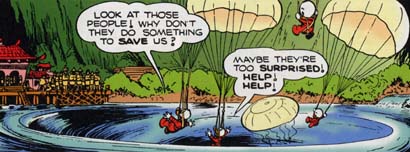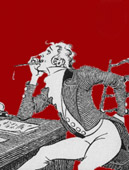| |
|
 Surfing the Whirlpool
Surfing the Whirlpool
By October 1953, when
he finished inking "Tralla La" and sent the story off
to his publisher, Carl Barks had some of his greatest work behind
him. "Lost in the Andes," "Ancient Persia,"
"The Golden Helmet"--everyone has his favorite, but
no one will dispute that the late 1940s and early 1950s were
Barks' golden years. There were masterworks to come, it's true,
but when you have been pursuing any subject for a decade, it's
hard to find fresh things to say. Past accomplishments hem you
in; wealth accumulated along the way must be sorted and reckoned
with. It's no coincidence that the Scrooge stories of this period
open inside the money bin on scenes of breakdown ("Tralla
La"), ennui ("The Seven Cities of Cibola"), and
illness ("The Mysterious Stone Ray"). As Barks was
fond of saying in later years, "The mind is not a bottomless
well, and mine is about pumped dry." Not until "The
Lemming with the Locket," which opens with a symbolic slamming
of the vault door, would the adventure tales take a new tack,
if not in subject matter, then in tone.
Having written about Barks
steadily for fifteen years, I find myself in a similar fix. Friends
tell me that I've recycled so many old articles of late, they
no longer look for the new ones. In a spirit that's part defiance,
part desperation, I have decided on a rash course. I shall critique
what is probably Barks' most famous and most perfect story, "Tralla
La." It won't be easy. Like the legendary Himalayan valley,
the tale is nearly impregnable. I have already published and
put behind me two analyses. If I am to say anything more, I shall
have to scale new heights.
You, like Donald and the
boys, are coming along.
Most critics pursue their
literary game (pun intended) with axes ready-ground. They know
what the story's about: it's about whatever cultural or political
issue interests them, and their job is to whack away at
the artwork until it submits to their paradigm. There's a use
for these busybodies: they get at things. In forty years Barks
has revealed nothing more than the fact that "Tralla La"
grew out of his desire to draw one billion of something--and
that, to use another phrase of his, is wind up the chimney. If
the modern theorist cuts away with skill and restraint, he can
shine some fascinating light into the dark corners of genius,
corners the artist might rather keep obscured. But there's always
a danger the artwork itself will collapse in a shower of chips,
leaving only the theory standing.
Other critics--among whom
I number myself--accord the artist a degree of political and
psychological privacy but still want to plumb his research, use
the story as a way of getting inside the workshop. Barks had
two sources for his Himalayan morality play: the Frank Capra
film of James Hilton's Lost Horizon, which provided the
germ of an idea; and a long, enthusiastic account of a trek to
Hunza in the National Geographic Magazine, which provided
everything else short of ducks. To recap briefly: at the northern
border of Pakistan, just under the rooftop of the world, perches
a tiny kingdom that could easily be Hilton's Shangri-La, an oasis
of apricot trees and green, terraced hillsides. The folk there
enjoy an isolated, peaceful, and Spartan way of life with no
great riches but no great hungers either--at least they did in
1953, when Jean and Franc Shor published their account of the
valley and Barks turned it into a Scrooge adventure. He must
have been drawn to the color photographs of fruit blossoms, rice
paddies, and a telltale V-shaped notch in the mountains. These
details all show up in his art, but the Shors' text is what really
sparked his story.
"Why should I have
a bodyguard?" the ruler of Hunza once asked his visitors.
"I have no enemies. Only once since I became Mir have we
been worried. Two years ago someone thought he had discovered
a rich vein of gold. Fortunately, it turned out he was mistaken."
It's plain Barks had this passage in mind when he described the
cliffs of Tralla La as "pure old rock! No gold or
jewels to contaminate the people!" Even the incident of
the honest rice farmer who retrieves Scrooge's bottle cap is
grounded in fact: a Hunza man once walked eight miles to return
Franc Shor's lost watch.
This mining in the Geographic
is a valuable exercise. It gives us the chance to watch a master
at work--and aren't most readers voyeurs? But it doesn't address
the crucial issue. Assuming that "Tralla La" speaks
to us, how does that happen? What makes it resonate in our minds?
Why do we collect it in first editions and reprints, read it,
reread it, and pester the artist to tell us what he ate for breakfast
the day that he wrote it? What is the story about?
On a narrative level,
"Tralla La" inverts the themes and threads of "The
Secret of Atlantis," its immediate predecessor. The ducks
travel to the roof of the world rather than its sunken depths,
pursue peace rather than riches, deflate a bottle cap's false
value rather than falsely inflating the worth of a coin, and
destroy an ancient civilization instead of leaving it intact.
The impulses of "Atlantis," from its half-page pie
fight to its final silly coda with Donald in the trash can, are
comedic. The impulse of "Tralla La" is tragic: a noble
quest and a noble society brought low. The story ends with paradise
nearly choked by bottle caps and Scrooge going into another nervous
breakdown.
I was irritated recently
to read an advertisement for the present edition which called
the comic a "textbook treatise on micro-economics."
Equally irritating perhaps was my own premise some five years
back, borrowed from Nathaniel Hawthorne, that Barks' story showed
us the degeneracy of the human heart. A Marxist critic would
probably tell you that "Tralla La" is about the destructive
effects of capitalism on a pre-industrial society. If we could
get Barks to open up about his private feelings in 1953, we might
discover that the comic is about stress, something he knew well
in the years following his divorce. How many other funny-animal
comics do you know that open with the hero having a nervous breakdown?
I know one, and it's also by Barks ("The Golden River,"
written four years later).
In 1984, when I published
my first major article on Scrooge, which grew out of a paper
on the ethics of collecting in Henry James' fiction, I received
a letter from a reader who identified as passionately with Scrooge
as I did with James' art patrons. "As a collector I am one
who uses beauty to distance myself from life," this duck
fan wrote. "The reconstruction of a happy childhood to avoid
the stress of a not quite as happy adulthood is paramount in
my comic collecting." He then proceeded to restate my arguments
with reference to his own life and anxieties, winding up with
the following observation: "As in 'Tralla La,' the ultimate
price of the collecting obsession is madness and the realization
that a collector can never escape the inner trappings of his
own mind."
What allowed this man
to connect with me, allowed me to connect with James, allowed
us both to connect with Barks? What makes a comic book set and
penned in the 1950s, built from scraps of travelogue and animation
gags, so vital and relevant today? It isn't the money fetish--tellingly
portrayed as bottle-capitalism--though that has fired America's
dynamos for more than a century. It's the emotion behind
that fetish. Working instinctively, Barks could reveal on the
comic page things he would never vouchsafe to an interviewer.
After his retirement, when it seemed there was no danger of his
having to illustrate the story, he wrote a brief scenario for
a new trek to the paradisal valley, stripped this time of its
glamour and called simply "Khunza" (a variant spelling).
His prefatory note says it all: "This is a tale of a great
need and a great fear."
"Tralla La"
is about every man's desire to escape, to be at peace. It is
also about the ultimate frustration of that desire. Again it's
no coincidence that paradise, like the money bin and the human
mind, has chaos at its core, pictured this time as a roiling
lake smack in the middle of the valley. "Throw them in the
whirlpool!" is a cry that comes readily to the angry mob
of Tralla Lalians; the torrent is never far from their minds.
We recall the ante-bellum world of Plain Awful--another happy
valley--where only one crime was possible, one terrible law held
sway ("Lost in the Andes"). The natives of Tralla La,
like their cousins in the Andes, have learned to live with death
on their doorstep. They stretch a net across it, but even then
they fear an accident that might dam the whirlpool and flood
their homes.
This becomes the ducks'
one bargaining chip: to play on the fear that unites them with
all mankind. It's Barks' method, too, as storyteller: invoke
terror, but in ways palatable to a Disney audience. For instance,
we are distracted from the nastier implications of Scrooge's
breakdown by the comic spectacle of the old duck sleeping squirrel-like
in a tree. When we do fall into the whirlpool, the net is there
to catch us. Such deft double-shuffles allowed Barks to explore
human trauma in a way unparalleled among funny-animal artists.
Donald Ault, who taught
me to think of the duck comics as something more than newsprint,
put it best nearly thirty years ago. "'Tralla La,'"
he said, "is about the explosion of Nirvana."
Today
that phrase comes closest to expressing my own feelings about
the story. It's not just a charming, funny, slightly frightening
treatise on the impossibility of paradise, but an explosion for
everyone who reads it. It stops us in our tracks and makes us
want to attach ourselves to it, collect it, use it to explain
our lives, make it fit our critical structures. The story quite
simply is about its own emotional impact. All great art is.
Don't get me wrong. The
comic's prevailing cynicism could probably be traced back to
Barks' mood in 1953. Its charm can be attributed to scraps of
atmosphere and incident borrowed from the National Geographic;
who among us is not moved by the tale of the lost watch? And
yes, it is a treatise on economics that carries a lesson
for Marxists and capitalists alike. That explains why we study
the story, not why we read it.
Art is about emotion.
Our emotion.

Copyright ©
1996 by Geoffrey Blum
Drawing copyright © 2003 by Disney Enterprises
First published in Uncle Scrooge Adventures in Color,
No. 6 (July 9, 1996) pp. 25-26.
|
|










|
|

